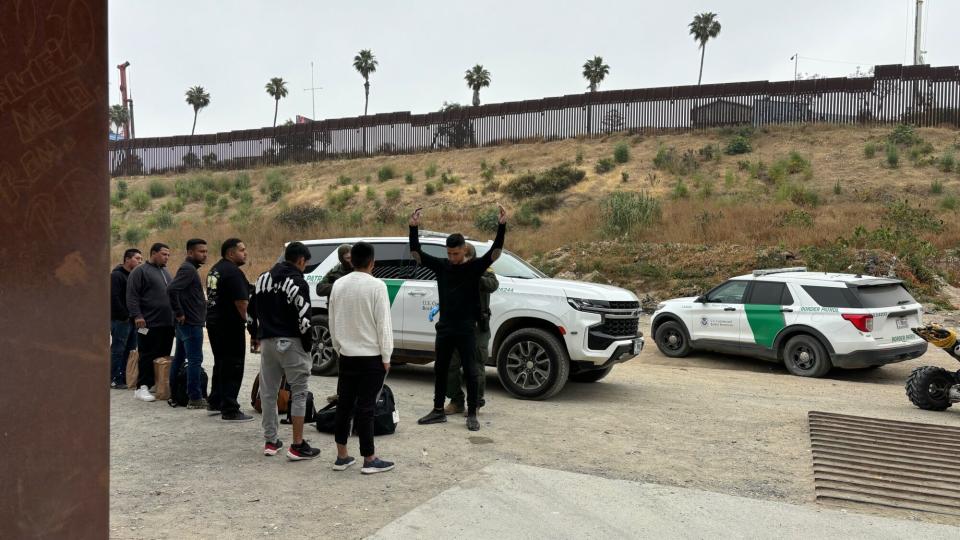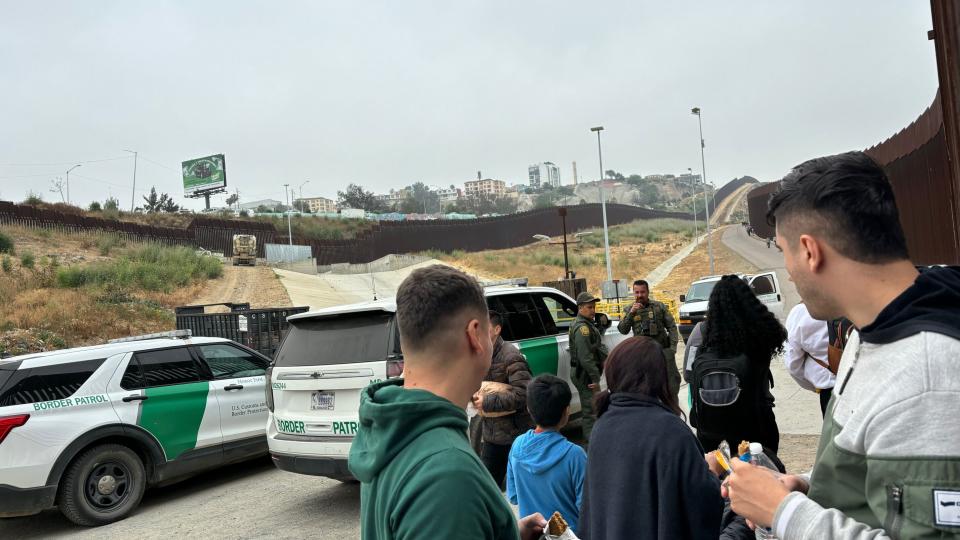Migrants Unaware of Biden Order Face New Rules in California
(Bloomberg) -- After scaling the 30-foot border wall south of San Diego during the early morning hours on Wednesday, 42-year-old Santiago Montenegro arrived at an open-air detention site cold, hungry and exhausted from the long journey he’d been on since leaving his native Colombia.
Most Read from Bloomberg
Real Estate Investors Are Wiped Out in Bets Fueled by Wall Street Loans
Billionaire-Friendly Modi Humbled by Indians Who Make $4 a Day
A Struggling Business Park Deals a Blow to Singapore's Regional Hub Ambitions
He was among more than 80 migrants who had crossed California’s southern border near Tijuana, Mexico, and were waiting for US Customs and Border Protection agents so they could request asylum.
They had arrived a day after President Joe Biden announced an executive order intended to discourage crossings by severely limiting migrants’ ability to request protection. Workers with local aid groups said that they were unsure about how the new policy was being enforced, and the people waiting to be picked up by agents were largely unaware of the rules.
It was unclear if many of those being processed would be quickly sent back to their home countries, as called for in the new order.
Two Homeland Security officials declined to give preliminary numbers of migrants subject to the new policy on Wednesday but they cautioned that it’s far too early to assess the impact. Border officials will begin to see the full strength of the policy in the coming days and weeks, a senior official told reporters. Its success will lie in whether overall border encounters drop and fast-tracked deportation numbers rise.
Informed about Biden’s order by a reporter, Montenegro said he would have tried to cross into the US regardless because he’s desperate to provide for a wife and three children in Colombia. He thinks other migrants like him are unlikely to abandon their quest, since many are fleeing violence, extortion and poor economic conditions.
“There are no work opportunities for me back home, and I have to find a way to provide for my family,” he said in Spanish. “I left everything. It was the most difficult decision of my life to leave them.”
The order announced this week effectively bars many asylum claims from those who cross the border between ports of entry — such as by simply walking across. Under the new rules, asylum rights are mostly suspended for those people when levels are averaging above 2,500 encounters a day from Texas, New Mexico, Arizona and California, as they are now.
Under the new policy, US officials said removals would happen within hours or days in some cases. People who are from Mexico, Cuba, Haiti, Nicaragua, and Venezuela are sent back to Mexico, under agreements that predate the changes; others are sent to their home countries, though officials acknowledge that’s difficult in some cases.
The overwhelmed system means that the goodwill of the American public is “wearing thin right now,” Biden said Tuesday at the White House, in announcing the changes. “I take these steps today not to walk away from who we are as Americans but to make sure we preserve who we are for future generations to come.”
At the Texas border, the state Department of Public Safety said the agents it has deployed to the region were conducting patrols as normal. In the Del Rio sector, a hotbed for new arrivals at the end of last year, unlawful border crossings have plummeted this year as migrants have shifted to locations in Arizona and California.
“The Texas Department of Public Safety maintains a proactive posture and will continue to use every tool and strategy to deter unlawful border crossings,” Lieutenant Christopher Olivarez, an agency spokesman, said in a message.
Outside San Diego, Pedro Rios, a local volunteer with the American Friends Service Committee, was handing out cups of hot soup when US agents arrived to take the migrants for processing. Despite the new order, the factors remain that are pushing migrants to leave their home countries, he said.
“The fact that there are this many people here means that they are still crossing,” he said in an interview.
In the past, after processing, migrants who have been given a court date to plead their asylum case are typically released and dropped off at transit stations, where they must find a way to get to their next destination.
Chris Enow, 33, a volunteer for the nonprofit Al Otro Lado who helps migrants released by the government navigate their way to the airport or reunite with their family members, said about 300 people were waiting for assistance as of early Wednesday.
Over the past six months, the San Diego border region saw a nearly 66% increase in border crossings from a year earlier, according to U.S. Customs and Border Protection data. The most recent numbers for the San Diego sector for the week through May 28 show that the agency apprehended 6,777 migrants from 67 countries, according to Chief Patrol Agent Patricia D. McGurk-Daniel.
--With assistance from Josh Wingrove and Julie Fine.
(Adds Texas law enforcement official’s comment in 11th paragraph.)
Most Read from Bloomberg Businessweek
Sam Altman Was Bending the World to His Will Long Before OpenAI
David Sacks Tried the 2024 Alternatives. Now He’s All-In on Trump
Startup Brings New Hope to the Pursuit of Reviving Frozen Bodies
©2024 Bloomberg L.P.

 Yahoo News
Yahoo News 


